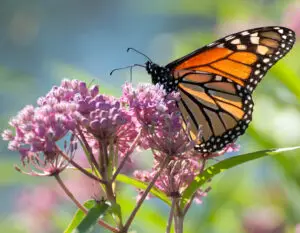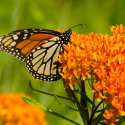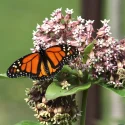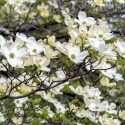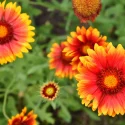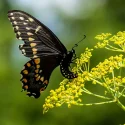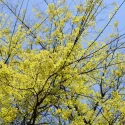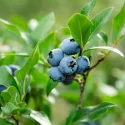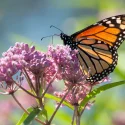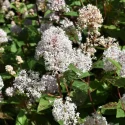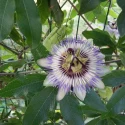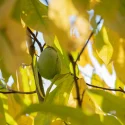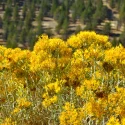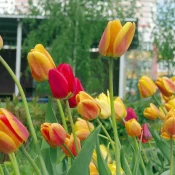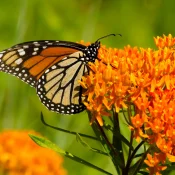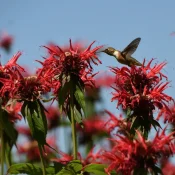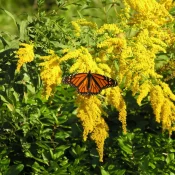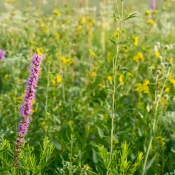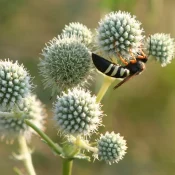Are butterfly bushes invasive?
Yes, butterfly bushes are invasive plants. While they may look like a good choice for attracting butterflies, they can quickly spread and choke out native plant life.
Their flowers do offer nectar, but butterfly bushes aren’t host plants for North American butterflies. Think of them like soda for butterflies—an occasional sweet treat, but they don’t provide the essential food or habitat butterflies need to survive and reproduce.
Remove butterfly bushes and replace them with native host plants (a well-known one is milkweed), which help butterfly populations thrive. Scroll on to find out why butterfly bush is a problem.
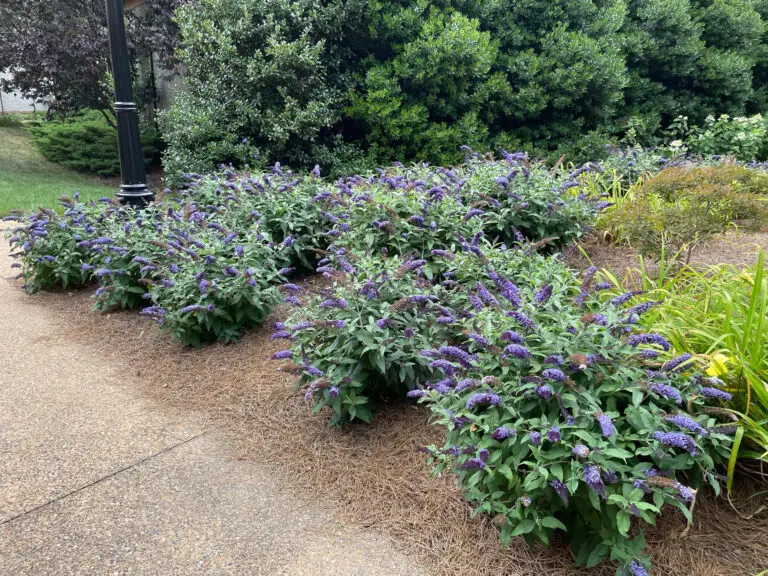
When you’re a beginner gardener visiting plant nurseries or big box stores, it’s easy to get excited when you spot a butterfly bush. These bushes are often advertised with colorful tags and signage touting their ability to attract butterflies.
But don’t let the name fool you.
Where did butterfly bushes come from?
Butterfly bushes are a great example of the power of naming and marketing. These plants, native to Asia, were introduced to North America in the 1800s as ornamental landscaping shrubs.
Now, that we know about their origins, let’s get to the bigger question:
Why are butterfly bushes bad?
Butterfly bushes are harmful in gardens for two reasons:
- They spread rapidly: a single plant can produce hundreds of thousands of seeds, allowing it to quickly take over.
- They out-compete native plants: Butterfly bushes take up space that’s vital for native host plants (a well-known one is milkweed), which butterflies rely on to lay their eggs and feed their caterpillars.
These two elements combined make butterfly bushes an invasive plant.
Just how invasive are butterfly bushes? Here’s how invasive they can be…
Butterfly bushes—a monster in our midst
Let me pitch you a movie.
The scene opens in a front yard in suburbia. It’s morning—the sun is rising, turning the clouds a gentle pink. We see a beautiful garden in the front yard, with several butterfly bushes swaying in the breeze.
It’s fall, and the once-purple flowers are turning into seed pods. In a few weeks, each long branch will end in a clustered cone.
A breeze lifts its branches. We see thousands of seeds released, each caught on the breeze. They drift everywhere: throughout the yard, in neighbors’ yards, into the street.
A stroller rolls by, catching seeds in its wheels and transplanting them to a house a mile away. The car in the driveway catches seeds under its wipers, inadvertently bringing them places hundreds of miles away.
The music suddenly becomes ominous.
We see the text onscreen:
The movie cuts to a monarch butterfly flitting around the garden. We watch her search and search for the only place she will lay her eggs—milkweed. (Milkweed is the only plant that a monarch caterpillar eats, so monarch moms only lay their eggs there. These dedicated plant/animal relationships are called host plants.)
Without milkweed, monarchs can't survive
We see the monarch mom fly off in vain. There is no food for her babies here.
The butterfly bush continues to smugly shed seeds, further reducing the monarch habitat through its invasiveness. Next spring, there will be even less food for monarchs.
Replace butterfly bushes with host plants
There are hundreds of host plants—like milkweed—that make our gardens beautiful and more resilient. Planting host plants helps butterfly moms and babies.
Explore our Host Plants for Butterflies to meet some butterfly bush replacements.
We have one more insight to share. Readers have written to The Plant Native asking:
What about sterile butterfly bush cultivars?
Some gardeners and nursery owners may genuinely believe that sterile butterfly bush cultivars—plants bred for specific traits—are safe because they’re marketed as not producing seeds. (Curious about cultivars? Check out our quick cultivar guide here.)
But here’s the catch: the term “sterile” is misleading.
Sterile doesn’t mean seedless
So-called sterile butterfly bushes don’t eliminate seed production entirely—they only reduce it. Even a small percentage of seeds can add up quickly.
The North Carolina Native Plant Society explains:
“A single shrub of straight-species butterfly-bush can produce up to 3 million seeds. Even if a cultivar’s fertility is reduced to 2% of a standard plant’s seed production, that still adds up to about 60,000 seeds, which are easily spread by wind and runoff water.”
Sterile butterfly bushes still produce pollen
Even if seed production is reduced, sterile butterfly bushes can still release viable pollen. This pollen can fertilize wild butterfly bushes (Buddleia davidii straight species), leading to new plants that may be even more invasive.
In some cases, these “sterile” plants can even regain their ability to produce seeds, further contributing to their spread.
Skip the butterfly bush cultivars
Because of these risks, so-called sterile cultivars aren’t truly safe for the environment. They should be treated the same as regular, fertile butterfly bushes.
Let’s skip the butterfly bushes altogether and focus on planting native plants that truly support pollinators.
Sadly, there are many invasive plants in our gardens
Butterfly bush is not alone. Common landscaping choices like English ivy or porcelain grape vines are also invasive. All these plants were brought to America from other places—mainly for landscaping reasons. These plants are so successful at reproducing that they have choked out native plants. Visit our Most Common Invasive Species article to learn more.
Remove butterfly bushes as soon as you can. Here’s how:
How do I remove a butterfly bush?
Removing butterfly bushes is straightforward: all it takes is a shovel and a contractor trash bag.
- Cut down the butterfly bush branches with clippers or a hand saw
- Put them in a contractor trash bag (invasive plants cannot be composted)
- Dig up the roots: dig in a circle around the stem until you can lift the rootball out
- Put the rootball into a contractor bag and throw it out with the trash
- Plant host plants!
The butterflies will thank you.
Help all the butterflies: plant native
Replace butterfly bushes with native host plants that support butterflies and pollinators. Planting native ensures our gardens will thrive no matter what weather arrives in our home area, and cuts down on watering and work (especially compared to lawns.) A yard with native plants will be filled with butterflies and songbirds. Find inspiration on butterfly bush replacements in our Native Host Plants for Butterflies guide, or explore our native plant library. Happy planting!
Sources
- Gould, Lisa Lofland. North Carolina Native Plant Society. “Chlorofiends! What’s up With ‘Sterile Cultivars’?,” January 21, 2024. https://ncwildflower.org/chlorofiends-whats-up-with-sterile-cultivars/.
- Cameron, Leslie. “Are Butterfly Bush Cultivars Labeled as ‘Sterile’ Environmentally Safer?,” Master Gardeners of Northern Virginia, October 31, 2023, https://mgnv.org/mg-in-the-garden/are-butterfly-bush-cultivars-labeled-as-sterile-environmentally-safer/.
- Marazzi, B., & De Micheli, A. 2019. Are sterile Buddleja cultivars really sterile and “environmentally safe”? Bollettino della Società ticinese di scienze naturali, 107, pp. 55-60 (ISSN 0379-1254). (PDF.)
- Ebeling, S.K., Welk, E., Auge, H. and Bruelheide, H. (2008), “Predicting the spread of an invasive plant: combining experiments and ecological niche model.” Ecography, 31: 709-719. https://doi.org/10.1111/j.1600-0587.2008.05470.x
- Nelson, Gil. Best Native Plants for Southern Gardens: A Handbook for Gardeners, Homeowners, and Professionals, (2010).
- Harstad, Carolyn. Go Native! Gardening with Native Plants and Wildflowers in the Lower Midwest. (1999).
- “Invasive Species Spotlight: The Truth About Butterfly Bush.” Brandywine Conservancy and Museum of Art, June 7, 2020. https://www.brandywine.org/conservancy/blog/invasive-species-spotlight-truth-about-butterfly-bush.
